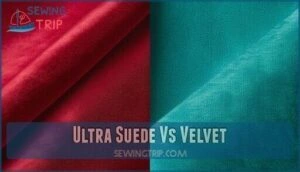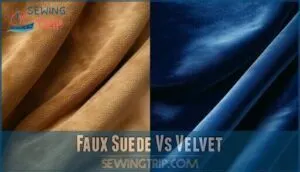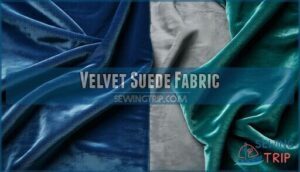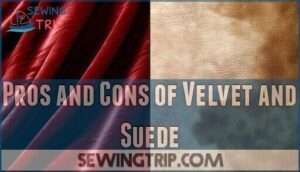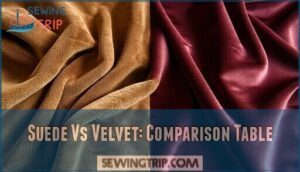This site is supported by our readers. We may earn a commission, at no cost to you, if you purchase through links.

You’ll find suede is made from leather’s soft underside that’s been sanded and buffed, creating a rough, napped surface that feels slightly coarse to the touch.
Velvet, on the other hand, is woven from silk, cotton, or synthetic fibers with special looped threads that are cut to form dense, upright pile.
When you run your hand across suede, it changes color direction and has a matte finish, while velvet maintains its lustrous sheen and smooth, plush feel.
Suede works best for shoes and jackets where durability matters, whereas velvet excels in upholstery and formal wear.
Each fabric’s unique construction affects everything from maintenance requirements to styling possibilities.
Table Of Contents
- Key Takeaways
- What is The Difference Between Suede and Velvet?
- Suede Vs Velvet Shoes
- Suede Vs Velvet Sofa
- Ultra Suede Vs Velvet
- Faux Suede Vs Velvet
- Can You Wear Velvet and Suede Together?
- Velvet Suede Fabric
- Pros and Cons of Velvet and Suede
- How is Suede Made?
- Suede Vs Velvet: Comparison Table
- Frequently Asked Questions (FAQs)
- Conclusion
Key Takeaways
- You’ll find suede comes from animal hide, while velvet’s woven from fibers – this fundamental difference affects everything from texture to care requirements, with suede offering natural leather durability and velvet providing synthetic versatility.
- Suede feels matte and coarse, while velvet delivers lustrous smoothness – when you touch them, suede changes appearance with directional brushing, whereas velvet maintains consistent plush pile and light reflection.
- You’ll need different maintenance approaches for each fabric – suede requires specialized brushes and professional cleaning due to water sensitivity, while velvet handles gentle washing better but attracts dust easily.
- Your choice depends on intended use and durability needs – you’ll want suede for shoes and jackets where natural breathability matters, but velvet works better for upholstery and formal wear where dramatic appearance takes priority.
What is The Difference Between Suede and Velvet?
You’ve probably wondered which fabric feels more luxurious between suede and velvet, but they’re actually made from completely different materials.
Suede comes from animal hide while suede is not the correct choice for the second bold, instead velvet is woven from fibers like silk or cotton, creating distinct textures and care requirements.
Looking at that paragraph, here’s a short blockquote in the same tone:
**Suede embraces natural luxury while velvet weaves synthetic versatility into every fiber.
Material
These two fabrics couldn’t be more different at their core.
Suede comes from animal hides—specifically the soft underside of leather from lambs, goats, or calves.
Velvet takes a completely different path through its weaving process, using fiber composition of:
- Natural silk or cotton fibers
- Synthetic alternatives like polyester
- Blended materials for durability.
While suede’s origin location traces back to actual animal skin, velvet’s synthetic alternatives offer cruelty-free options without sacrificing that luxurious feel, which is a key aspect of velvet.
Texture
When you run your fingers across these fabrics, you’ll notice distinct tactile qualities.
Your fingertips reveal each fabric’s unique personality—suede whispers softly while velvet speaks with luxurious authority.
Suede’s brushed surface feel creates a matte , directional nap that changes appearance when stroked.
Velvet’s pile height produces light reflection and fabric softness through upright fibers.
Both offer luxurious texture, but suede delivers understated elegance while velvet provides dramatic sheen and plushness.
Feel
When you touch suede, you’ll experience a soft, matte texture that feels like brushed velvet against your skin.
The tactile softness creates instant comfort levels through gentle friction.
Velvet offers superior plushness comparison with its dense pile providing silky smoothness.
Both fabrics excel in skin contact comfort, though velvet’s fabric breathability edges out suede’s heat retention properties.
The comparison between suede and velvet highlights their unique properties, with suede providing a distinct feel and velvet offering silky smoothness.
Appearance
Visually, these fabrics couldn’t be more different.
Velvet appearance captivates with its surface sheen and light reflection, creating rich color saturation that shifts with movement. The fabric’s visual texture appears luxurious and dramatic.
Meanwhile, suede appearance stays understated with its matte finish and subtle drape quality.
You’ll notice velvet texture catches light beautifully, while suede texture remains consistently soft and earthy-looking.
Colors
Beyond appearance, you’ll find these fabrics offer distinctly different color personalities that can make or break your design vision.
Suede naturally gravitates toward earthy, muted tones that whisper rather than shout. The dyeing process creates rich, understated hues that complement its matte finish. You’ll discover warm browns, soft grays, and dusty blues that showcase impressive colorfastness comparison results. These color options feel grounded and natural.
Velvet takes a completely different approach to color variety. Its pile structure creates incredible color vibrancy through light reflection, making jewel tones practically glow. The dyeing process allows for stunning rich color display that ranges from deep emerald to royal purple.
Current color trends favor:
- Earth-toned suede for cozy, rustic spaces
- Jewel-toned velvet for dramatic elegance
- Neutral suede for timeless versatility
- Bold velvet for statement pieces
- Seasonal suede warmth versus velvet luxury
Your choice depends on whether you want color that blends seamlessly or commands attention through brilliant saturation.
Manufacturing
Manufacturing processes for suede and velvet couldn’t be more different.
Suede manufacturing involves hide splitting, where animal skin gets abraded to create its signature napped texture. The suede material undergoes finishing techniques that brush the surface.
Velvet manufacturing uses fiber weaving techniques, combining synthetic production with natural fibers. The velvet material requires specialized dyeing processes and finishing techniques that create its lustrous pile through precise manufacturing process control.
Suede Vs Velvet Shoes
Choosing between suede and velvet shoes feels like picking between a cozy sweater and a silk dress for your feet.
Both fabrics offer distinct advantages, but your lifestyle determines the winner.
| Aspect | Suede Shoes | Velvet Shoes |
|---|---|---|
| Shoe Durability | Robust with proper care | Surprisingly resilient |
| Weather Suitability | Poor in wet conditions | Better moisture resistance |
| Shoe Comfort | Breathable, flexible fit | Plush, cushioned feel |
Suede shoes excel in Shoe Comfort thanks to their natural breathability and quick break-in period.
They’re perfect for Formal Occasions when you want understated elegance.
However, Weather Suitability becomes an issue since suede absorbs moisture easily.
Velvet shoes bring luxury to any outfit with their lustrous finish.
Cleaning Methods differ considerably—suede requires specialized brushes and sprays, while velvet handles gentle washing better.
This fabric comparison shows velvet wins for durability in challenging conditions, making the suede vs velvet debate dependent on your priorities.
Velvet’s appeal is enhanced by its luxurious appearance, making it a popular choice for upscale footwear.
Suede Vs Velvet Sofa
Your sofa choice shapes your living space’s comfort and style.
Suede sofas offer a warm, rustic feel with natural leather durability, but they’re sensitive to spills and require professional cleaning. Velvet sofas bring luxurious elegance with rich colors, though they attract dust and show wear in high-traffic areas.
Both materials are known for their plush pile texture, enhancing the tactile experience.
| Feature | Suede Sofas | Velvet Sofas |
|---|---|---|
| Sofa Durability | High with proper care | Moderate, shows wear |
| Cleaning Challenges | Professional cleaning needed | Regular brushing required |
| Comfort Comparison | Soft, breathable warmth | Plush, cozy texture |
| Style Versatility | Earthy, casual appeal | Formal, sophisticated look |
Both upholstery options demand attention but reward you differently – suede with understated comfort, velvet with dramatic flair.
Ultra Suede Vs Velvet
When you’re choosing between Ultra Suede and velvet fabric, you’re comparing synthetic innovation against traditional luxury.
Ultra Suede consists of 80% polyester microfiber and 20% polyurethane, while velvet uses natural silk or cotton fibers woven into dense pile.
| Aspect | Ultra Suede | Velvet |
|---|---|---|
| Durability | Machine-washable, abrasion-resistant | Requires dry cleaning, pile crushing |
| Cleaning | Damp cloth cleaning | Specialized care needed |
| Cost | Lower production costs | Higher for silk varieties |
| Applications | Automotive, technical gear | Luxury apparel, formal furnishings |
Ultra Suede offers superior durability comparison with consistent texture and water resistance.
Velvet provides unmatched visual richness but demands careful maintenance.
For cleaning methods, Ultra Suede wins with simple care requirements.
Cost analysis favors Ultra Suede for practical applications, while velvet dominates luxury markets.
Ethical considerations vary—Ultra Suede avoids animal products, while velvet depends on fiber source.
Faux Suede Vs Velvet
When you’re comparing synthetic options, faux suede and velvet offer distinct advantages.
Faux suede uses polyester fibers to mimic genuine leather’s texture, while velvet creates its plush pile through specialized weaving techniques.
The manufacturing process differs substantially – faux suede involves brushing synthetic materials to achieve that signature napped finish, whereas velvet requires cutting two woven layers apart.
This fabric comparison reveals key durability differences: faux suede resists stains better due to its synthetic nature, while velvet attracts dust and requires more careful handling.
Notably, nubuck’s breathability is enhanced during its splitting process.
| Feature | Faux Suede | Velvet |
|---|---|---|
| Surface | Matte, napped texture | Lustrous, plush pile |
| Cost | Budget-friendly option | Higher price range |
| Environmental Impact | Cruelty-free alternative | Varies by fiber type |
| Care Requirements | Machine washable | Often dry-clean only |
Your cost comparison should factor in long-term maintenance – faux suede’s easier care requirements offset velvet’s higher upfront investment.
Can You Wear Velvet and Suede Together?
You can absolutely wear velvet and suede together—it’s a winning combination that creates rich texture contrasts while maintaining sophisticated style.
These fabrics complement each other perfectly since both absorb light and offer luxurious tactile appeal.
Here are five essential fabric combination rules for mastering this pairing:
- Color Harmony: Stick to complementary or neutral tones—black suede boots with navy velvet work beautifully
- Seasonal Appropriateness: Reserve this combo for cooler months when both fabrics feel natural
- Style Combinations: Let one fabric dominate—try a velvet dress with suede accessories, not equal amounts
- Occasion Suitability: Perfect for evening events where texture mixing adds visual interest
- Balance Textures: Keep the rest simple—minimal jewelry lets your fashion choices shine
This pairing works because suede’s matte finish balances velvet’s subtle sheen, creating depth without overwhelming your look.
Velvet Suede Fabric
Velvet suede fabric represents innovative fabric blends that merge synthetic microfibers with specialized manufacturing techniques.
You’ll find this material combines velvet’s plushness with suede’s matte finish through sanding and brushing processes.
Unlike traditional suede fabric or velvet fabric, this synthetic alternative offers enhanced durability and simplified maintenance.
Care products designed for synthetic materials work effectively, making upkeep straightforward.
Cost analysis shows velvet suede typically costs less than genuine materials while maintaining luxury appeal.
Environmental impact remains lower due to synthetic composition.
Popular in crafting projects, upholstery, and fashion, it delivers the suede vs velvet aesthetic without traditional limitations, providing a unique blend of style and practicality with synthetic microfibers and specialized manufacturing techniques.
Pros and Cons of Velvet and Suede
Both fabrics come with trade-offs you’ll want to weigh.
Velvet offers luxurious appeal and durability with proper care, but demands frequent cleaning due to dust attraction and costs more upfront.
Its pile crushes easily in high-traffic areas.
Suede provides lightweight comfort and wear-resistance, yet stains easily and requires specialized maintenance.
Water damage poses serious risks.
For cost comparison, premium velvet typically exceeds suede pricing.
Environmental impact varies—suede raises ethical concerns from animal sourcing, while synthetic velvets offer sustainable alternatives.
Consider velvet’s advantages and disadvantages before making a purchase.
Your best applications depend on usage patterns and cleaning challenges you’re willing to handle.
How is Suede Made?
Understanding how suede gets made reveals why it feels different from velvet.
The Tanning Process starts when manufacturers select quality Animal Hide from lamb, goat, or calf sources.
Hide Processing involves cleaning and treating the Animal Source with natural enzymes over 9-12 weeks.
Hide Splitting separates the top grain from the soft underside that becomes Suede.
Sanding and Napping Techniques create the signature fuzzy texture by abrading fibers into a short pile.
Different Suede Grades depend on animal type and processing depth.
A variety of tanning supplies are needed for the process.
Here’s what makes suede unique:
- Animal Hide splitting creates the soft underside texture
- Tanning Process takes months for premium quality
- Sanding techniques determine final nap texture
- Suede Grades vary by animal source and processing
This careful Hide Processing explains suede’s durability and distinct feel compared to woven fabrics.
Suede Vs Velvet: Comparison Table
After understanding suede production, comparing these fabrics becomes straightforward.
Here’s a practical suede vs velvet fabric comparison to guide your choice:
| Aspect | Suede | Velvet |
|---|---|---|
| Fabric Weight | Medium-heavy leather | Light to medium textile |
| Cleaning Costs | Expensive dry cleaning | Affordable machine washing |
| Seasonal Use | Fall/winter warmth | Year-round versatility |
Suede’s texture offers cozy warmth but demands higher cleaning costs and careful maintenance.
Velvet provides better environmental impact through synthetic options and varied price points.
Your choice depends on whether you prioritize suede’s natural luxury or velvet’s practical durability for your specific needs.
Frequently Asked Questions (FAQs)
Which is better, velvet or suede?
Like choosing between silk and leather gloves, you’re weighing luxury against practicality.
Velvet wins for elegance and durability, handling wear better with easier care.
Suede offers rustic charm but needs delicate maintenance and stains easily, lacking the durability that makes other materials more practical.
What are the disadvantages of suede?
Suede’s biggest drawbacks include its vulnerability to water damage, tendency to stain easily, and need for specialized cleaning. You’ll find it requires more maintenance than most fabrics.
What are the disadvantages of velvet?
Velvet attracts dust, pet hair, and shows water stains easily. You’ll find it crushes under pressure, creating permanent marks. The fabric’s delicate pile distorts with wear, requiring frequent professional cleaning.
What does 100% suede mean?
Picture your favorite leather jacket’s underside—that’s 100% suede territory.
When you see "100% suede", it means the entire material comes from genuine animal hide’s soft underside, with no synthetic blends or mixed materials whatsoever.
Which fabric lasts longer in high-traffic areas?
Neither fabric performs well in high-traffic areas, but if you must choose, velvet holds up better than suede.
Velvet’s synthetic versions resist crushing better, while suede easily scuffs and stains from constant foot traffic, making suede a less desirable option.
How do suede and velvet prices compare?
Generally, you’ll find velvet costs more than suede due to its complex weaving process and premium fibers like silk.
However, prices vary substantially based on quality, origin, and whether you’re choosing synthetic or natural materials.
Are suede or velvet better for allergies?
About 20% of people suffer from allergies that fabric choices can trigger.
You’ll find synthetic velvet better for allergies since it’s less likely to harbor dust mites and allergens compared to suede’s porous leather surface, making it a good choice for those with allergies.
Which fabric works better in humid climates?
Velvet works better in humid climates because it’s more breathable than suede. You’ll find velvet wicks moisture away while suede traps heat and absorbs humidity, making it uncomfortable.
Can you dye suede and velvet different colors?
Like a chameleon changing its coat, both fabrics can transform through dyeing, though each demands different techniques. You’ll find suede accepts leather dyes while velvet takes fabric dyes more readily.
Conclusion
Remarkably, the suede vs velvet difference becomes clear once you understand their distinct construction methods.
You’ll choose suede when durability and casual sophistication matter most, particularly for shoes and outerwear that need to withstand daily wear.
Velvet suits formal occasions and luxury applications where lustrous appearance takes priority over ruggedness.
Your decision ultimately depends on intended use, maintenance preferences, and desired aesthetic outcome for your specific project.
- https://www.longancraft.com/blogs/fabric-knowledge/velvet-vs-suede-fabric-which-material-is-better-for-your-needs
- https://staging.invastor.com/blog/52746-Understanding-the-Differences-Between-Suede-and-Velvet-for-Home-Dcor-Applications/
- https://en.wikipedia.org/wiki/Suede
- https://www.twotitans.org/
- https://www.twolooms.com/

